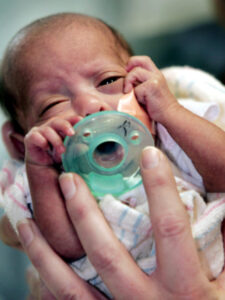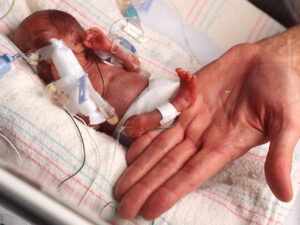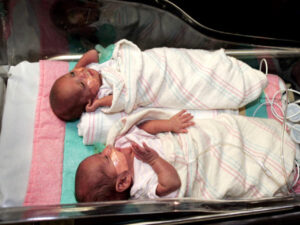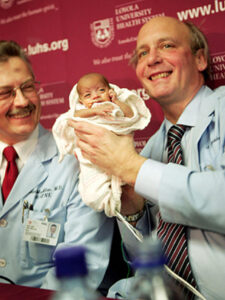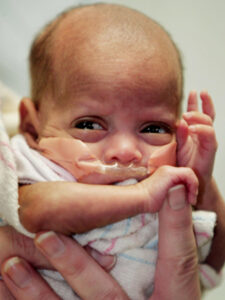Babies are the world’s smallest people – so what happens when they are born premature? Preemies enter the world in fragile condition, often weighing much less than full-term babies and facing health problems because their organs have not had enough time to develop. As a result, they need special medical care in a neonatal intensive care unit (NICU).
How do premature babies fare as they grow up? It all depends. Two of the tiniest babies ever born have beat long odds and are growing up healthy today – one, Rumaisa Rahman, a healthy first-grader, and the other, Madeline Mann, an honors college student. Another preemie – believed to be the world’s third-tiniest – Melinda Star Guido, is just about to embark on life outside the hospital. Keep clicking to see photos and learn more about some of the world’s tiniest babies…
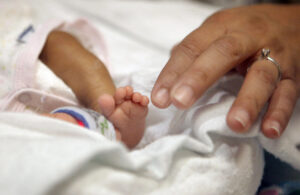
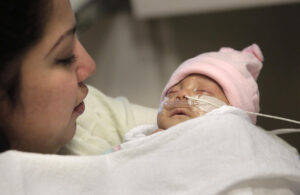
Rumaisa was born September 19, 2004 at Loyola University Medical Center in Maywood, Ill. Weighing 9.2 ounces at birth, she is the smallest known surviving baby.
Rumaisa was born with a fraternal twin sister, Hiba, who weighed 1 pound, 4 ounces at birth.
Rumaisa and Hiba on December 21, 2004, before they are wheeled into a press conference.
Rumaisa was delivered by cesarean section more than a month early because her mother had developed severe pre-eclampsia, dangerously high blood pressure that occurs during pregnancy. When she was born, Rumaisa was hooked up to a breathing machine with tubes as slender as strands of spaghetti slipped down her airways.
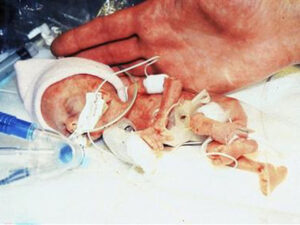
Rumaisa is introduced to the public by Dr. William MacMilliam (left) and Dr. Jonathan Muraskas. Dr. Muraskas
resuscitated Rumaisa and another tiny preemie, Madeline, at the Loyola University Medical Center. But he says that they are “extreme cases,” and “should not be considered ‘a benchmark’ to mean that doctors should try to save all babies so small.”
Rumaisa and Hiba carried by their parents, Mohammed Abdul Rahman (left) and Mahajabeen Shaik. Their mother was given steroid drugs to speed up the growth of her babies’ immature lungs.
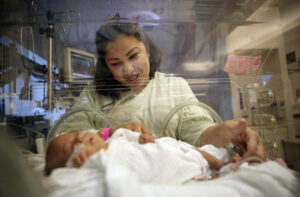
Rumaisa’s name means she is “white as milk” in India.
At age 5, Rumaisa weighed 33 pounds and was 3 1/2 feet tall, smaller than about 90 percent of kids her age. She is now 7 years old.
Madeline Mann was born in June 1989 at the Loyola University Medical Center, weighing 9.9 ounces. She had mild brain bleeding, common in tiny preemies, but with no lasting effects. Madeline and Rumaisa were treated for an eye condition common in preemies called retinopathy, which in severe cases can cause blindness.
Madeline is now a 22-year-old honors student in psychology. She has asthma and remains petite – 4 foot 8 and about 65 pounds at age 20 – but has no other lasting health problems.
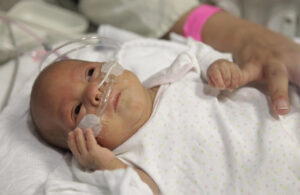
Jim Mann, Madeline’s father, said having a baby born so small was “terrifying” at first. That she has done so well is a source of pride, and wonder, he said. “I don’t know why, we were just extraordinarily lucky.”
Melinda Starr Guido was born on August 30, 2011, weighing only 9 1/2 ounces – less than a can of soda, at the Los Angeles County-USC Medical Center in Los Angeles.
Most babies as small as Melinda don’t survive. “The first few weeks, it was touch-and-go. None of us thought the baby was going to make it,” said Dr. Rangasamy Ramanathan, who oversees premature infants at the hospital.
Ibarra, who previously had a stillborn, told doctors to do whatever necessary to help her baby. “They said, ‘We’ll take the chance. Please try.’ So we said. ‘OK we’ll try,”‘ Ramanathan recalled. Even if she survived, doctors told mother Haydee Ibarra and her husband, Yovani Guido, children born this extremely premature can have developmental delays and impairments such as blindness, deafness or cerebral palsy.
Melinda was delivered by cesarean section at 24 weeks and was immediately transferred to the neonatal intensive care unit (NICU), where a team of doctors and nurses kept watch around the clock. Infants born before 37 weeks are considered premature.
Melinda was kept insulated in an incubator and was hooked up to a machine to aid her breathing. She got nutrition through a feeding tube. Her mother said her skin felt like plastic because it was so thin.
Melinda is believed to be the second smallest baby to survive in the United States and the third smallest in the world.
On Jan. 20, 2012, after spending nearly five months at the hospital, Melinda weighed 4 1/2 pounds and doctors said she had made enough progress to be discharged. It’s too early to know how she will fare developmentally and physically, but doctors plan to monitor her for the next six years.
